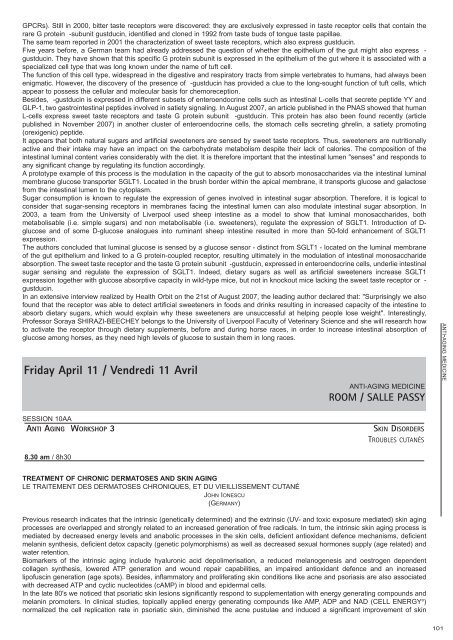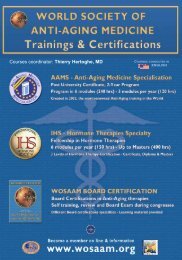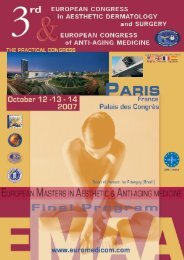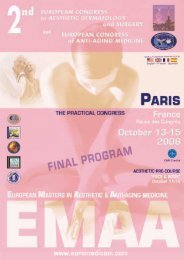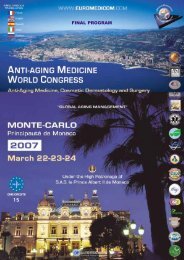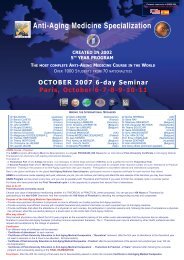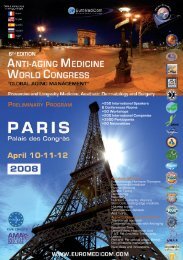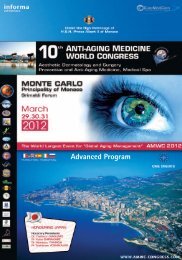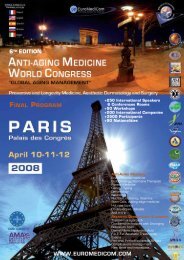FINAL PROGRAM 6TH EDITION - EuroMediCom
FINAL PROGRAM 6TH EDITION - EuroMediCom
FINAL PROGRAM 6TH EDITION - EuroMediCom
Create successful ePaper yourself
Turn your PDF publications into a flip-book with our unique Google optimized e-Paper software.
GPCRs). Still in 2000, bitter taste receptors were discovered: they are exclusively expressed in taste receptor cells that contain therare G protein -subunit gustducin, identified and cloned in 1992 from taste buds of tongue taste papillae.The same team reported in 2001 the characterization of sweet taste receptors, which also express gustducin.Five years before, a German team had already addressed the question of whether the epithelium of the gut might also express -gustducin. They have shown that this specific G protein subunit is expressed in the epithelium of the gut where it is associated with aspecialized cell type that was long known under the name of tuft cell.The function of this cell type, widespread in the digestive and respiratory tracts from simple vertebrates to humans, had always beenenigmatic. However, the discovery of the presence of -gustducin has provided a clue to the long-sought function of tuft cells, whichappear to possess the cellular and molecular basis for chemoreception.Besides, -gustducin is expressed in different subsets of enteroendocrine cells such as intestinal L-cells that secrete peptide YY andGLP-1, two gastrointestinal peptides involved in satiety signaling. In August 2007, an article published in the PNAS showed that humanL-cells express sweet taste receptors and taste G protein subunit -gustducin. This protein has also been found recently (articlepublished in November 2007) in another cluster of enteroendocrine cells, the stomach cells secreting ghrelin, a satiety promoting(orexigenic) peptide.It appears that both natural sugars and artificial sweeteners are sensed by sweet taste receptors. Thus, sweeteners are nutritionallyactive and their intake may have an impact on the carbohydrate metabolism despite their lack of calories. The composition of theintestinal luminal content varies considerably with the diet. It is therefore important that the intestinal lumen "senses" and responds toany significant change by regulating its function accordingly.A prototype example of this process is the modulation in the capacity of the gut to absorb monosaccharides via the intestinal luminalmembrane glucose transporter SGLT1. Located in the brush border within the apical membrane, it transports glucose and galactosefrom the intestinal lumen to the cytoplasm.Sugar consumption is known to regulate the expression of genes involved in intestinal sugar absorption. Therefore, it is logical toconsider that sugar-sensing receptors in membranes facing the intestinal lumen can also modulate intestinal sugar absorption. In2003, a team from the University of Liverpool used sheep intestine as a model to show that luminal monosaccharides, bothmetabolisable (i.e. simple sugars) and non metabolisable (i.e. sweeteners), regulate the expression of SGLT1. Introduction of D-glucose and of some D-glucose analogues into ruminant sheep intestine resulted in more than 50-fold enhancement of SGLT1expression.The authors concluded that luminal glucose is sensed by a glucose sensor - distinct from SGLT1 - located on the luminal membraneof the gut epithelium and linked to a G protein-coupled receptor, resulting ultimately in the modulation of intestinal monosaccharideabsorption. The sweet taste receptor and the taste G protein subunit -gustducin, expressed in enteroendocrine cells, underlie intestinalsugar sensing and regulate the expression of SGLT1. Indeed, dietary sugars as well as artificial sweeteners increase SGLT1expression together with glucose absorptive capacity in wild-type mice, but not in knockout mice lacking the sweet taste receptor or -gustducin.In an extensive interview realized by Health Orbit on the 21st of August 2007, the leading author declared that: "Surprisingly we alsofound that the receptor was able to detect artificial sweeteners in foods and drinks resulting in increased capacity of the intestine toabsorb dietary sugars, which would explain why these sweeteners are unsuccessful at helping people lose weight". Interestingly,Professor Soraya SHIRAZI-BEECHEY belongs to the University of Liverpool Faculty of Veterinary Science and she will research howto activate the receptor through dietary supplements, before and during horse races, in order to increase intestinal absorption ofglucose among horses, as they need high levels of glucose to sustain them in long races.Friday April 11 / Vendredi 11 AvrilANTI-AGING MEDICINEROOM / SALLE PASSYANTI-AGING MEDICINESESSION 10AAANTI AGING WORKSHOP 3 SKIN DISORDERSTROUBLES CUTANÉS8.30 am / 8h30TREATMENT OF CHRONIC DERMATOSES AND SKIN AGINGLE TRAITEMENT DES DERMATOSES CHRONIQUES, ET DU VIEILLISSEMENT CUTANÉJOHN IONESCU(GERMANY)Previous research indicates that the intrinsic (genetically determined) and the extrinsic (UV- and toxic exposure mediated) skin agingprocesses are overlapped and strongly related to an increased generation of free radicals. In turn, the intrinsic skin aging process ismediated by decreased energy levels and anabolic processes in the skin cells, deficient antioxidant defence mechanisms, deficientmelanin synthesis, deficient detox capacity (genetic polymorphisms) as well as decreased sexual hormones supply (age related) andwater retention.Biomarkers of the intrinsic aging include hyaluronic acid depolimerisation, a reduced melanogenesis and oestrogen dependentcollagen synthesis, lowered ATP generation and wound repair capabilities, an impaired antioxidant defence and an increasedlipofuscin generation (age spots). Besides, inflammatory and proliferating skin conditions like acne and psoriasis are also associatedwith decreased ATP and cyclic nucleotides (cAMP) in blood and epidermal cells.In the late 80's we noticed that psoriatic skin lesions significantly respond to supplementation with energy generating compounds andmelanin promoters. In clinical studies, topically applied energy generating compounds like AMP, ADP and NAD (CELL ENERGY ® )normalized the cell replication rate in psoriatic skin, diminished the acne pustulae and induced a significant improvement of skin101


